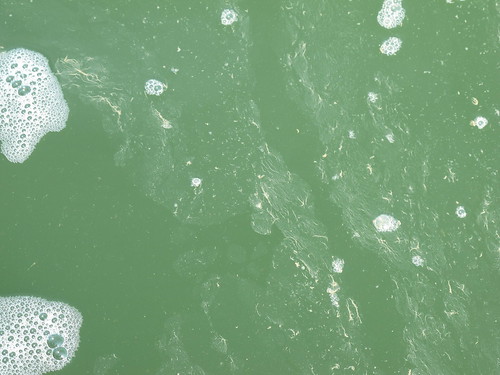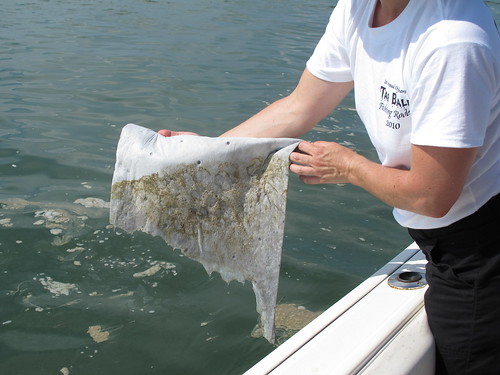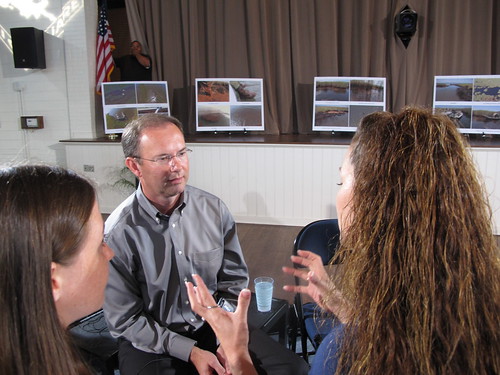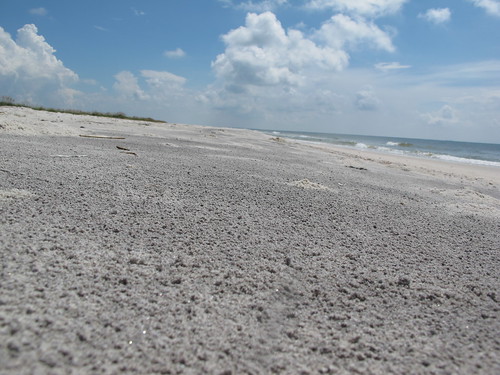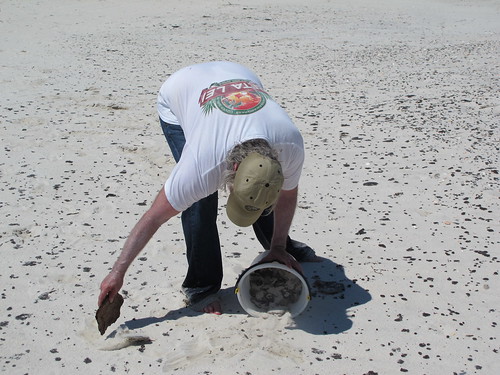Oily mix and tar balls pollute waters near Dauphin Island, AL
Crossposted from NRDC's Swithboard.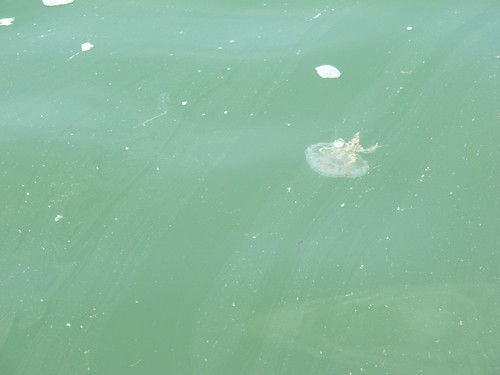
By Rocky Kistner
Last Friday, Pat Carrigan motored his twin-engine 25 ft boat out of his dock on Dauphin Island, one of Alabama’s most popular beach resorts and a barrier island known for its sandy beaches and prolific sea life. It's always been a popular resort destination for fishermen and vacationers along the Gulf coast and beyond.
But not now. Business is bad, and fishing is nearly non-existent. Many fear the economy here will take years to recover. “I moved here to enjoy life and live my dream,” says Carrigan, a retired businessman and fisherman who has worked on the BP cleanup with his boat. “But now we have this to deal with. And no one knows when it will ever end.”
Carrigan headed out along the Dauphin Island sound with Zack Carter, an organizer with the South Bay Communities Alliance, along with a documentary crew and author Antonia Juhasz, who’s writing a book about the oil disaster. The sun was hot and the bay was strangely empty of fishing boats that normally ply these waters. Commercial fishing was open here, but few boats were out. Commercial docks were still closed in some places and the public appetite for Gulf seafood was lousy. Despite federal and state assurances the seafood was safe, people still feared the oil in the water and its impact on local seafood.
Soon we began to see why. A stream of oily sheen and bubbles mixed with a brown and white residue snaked along in the water, a long thin line that stretched out at far as the eye could see. Was it oil and dispersant? At first we couldn’t tell what it was. But as we examined it closer, the oily smell and sheen was undeniable. It definitely appeared to be some kind of petroleum product. Jellyfish clung to the film on the surface. What was below no one could tell.
Zack got out a bucked and took a sample of the shiny, bubbly brown mix. He is sending it to a lab to confirm exactly what was in the water. The day before, we had seen huge plastic containers marked with Corexit warning labels on the dock public docks near Bayou La Batre. Reports from fisherman across the Gulf persist that Corexit is being sprayed from BP cleanup boats, something the company and government officials deny. But a dispersant-oily mix appeared to spread out in the water before us.
The next day at a town hall meeting in Buras, LA, BP Mobile Incident Commander Keith Seilhan was asked about the use of chemical dispersants. “We are not using dispersants and haven’t been for some time,” he said. But when asked whether contractors who operate in state waters could be, he said he could not be certain. “We have lots of contractors, but no one should be using them. If they are, we need to know about it and stop it.”
Here in Alabama's Gulf waters, it certainly looked like someone was using them. But until test results verify what exactly this oily sheen like mix is, no one can be sure. The only thing certain is that no one on the boat wanted to go fishing right there.
But in the distance a few fishing boats patrolled the waters, trolling in an area that could be contaminated with oil. That would violate regulations that prohibit commercial fishing waters be open when oil sheen is present in the water.
But what we found later was equally disturbing. Carrigan pulled the boat up to the west end of Dauphin Island, an isolated area that had been cut off from the rest of the island by the huge swells of Katrina. Now it was a peaceful destination for locals who bring their boats out here and enjoy the beautiful, quiet surroundings cutoff from the hubbub of the mainland. It was paradise.
Except for the tar balls and black stains on the beach. Brown and black balls of petroleum were littered along the sand like tiny rocks on the moon. It was impossible to walk on the beach without stepping on them. Some were continuing to wash into the shore. No one else was on the beach. Only seabirds populated it now, oblivious to the brown crude balls that scattered in the sand like cluster bomblets. Zack got out his trusty bucket and scooped up some samples to send away for testing.
“It’s disgusting,” Carrigan said as he scanned the once pristine beach he loves to visit and vacation on with his family and friends. “Someone should be out here cleaning this up now.”
But no one was to be seen except us, photographing evidence of the world’s worst maritime oil disaster ever. In Washington and in state capitals around the Gulf, politicians continue to stick to their guns that most of the oil has been cleaned up or harmlessly dispersed.
Perhaps, but many fishermen here don't believe it. The oil is still here and is not going away. And no one knows when life can start to return to normal again.

